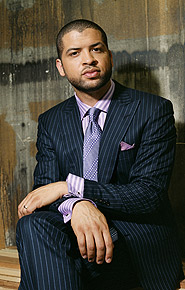Berkeleyan
Jason Moran's adventurous imprint
The pianist, who counts Egon Schiele and Alban Berg among his influences, is coming to campus to deliver 'a hard dosage of music'
![]()
| 26 October 2006
Given pianist Jason Moran's penchant for contemporary art, it's not surprising that when asked to classify his music, he answers "contemporary jazz" without hesitation.
 Jason Moran |
Like the 20th-century painters who have inspired some of his compositions - Jean-Michel Basquiat, Egon Schiele, and Robert Rauschenberg - Moran, who performs with his trio on Saturday, Nov. 4, in Wheeler Auditorium under the auspices of Cal Performances, has dedicated himself to forging new artistic territory. And similar to those modern visual artists, Moran grapples with form and abstraction while rooting his compositions in traditional jazz rhythms and harmonies. The result is edgy, original music.
Moran, who says he "thrives on being in vastly different situations," tackled three commissions last year from a trio of disparate arts institutions: the Walker Art Center in Minneapolis, Manhattan's Jazz at Lincoln Center, and the Dia Art Foundation in Beacon, N.Y. Moran's latest Blue Note recording, Artist in Residence, captures the musical products of all three commissions - which, he says in retrospect, offered him "a way to step beyond my bounds and stretch my legs further than I have before compositionally."
Moran's Berkeley audience will be treated to selections from Artist in Residence as well as pieces from his previous release, Same Mother, which took as its jumping-off point roadhouse and gutbucket blues.
The Jazz at Lincoln Center commission, RAIN, is based on the "ring shout," a counterclockwise circular dance from 19th-century African American slave culture that included percussive stick-beating and hand-clapping. On Milestone, which resulted from the Walker Art Center commission, Moran, the museum's 2004-05 artist-in-residence, collaborated with African American conceptual artist Adrian Piper, who addresses issues of racism, gender, art-world elitism in her work. And The Shape, the Scent, the Feel of Things, a multimedia performance piece on which Moran teamed with pioneering video/performance artist Joan Jonas, was inspired by the essays of German art historian Aby Warburg, who visited the American Southwest in the late 1890s to examine Hopi culture.
Jazz star rising
Although Artist in Residence can't replicate the experience of being in the audience at Dia:Beacon or the other spaces where Moran performed the commissions, it does document the music, all of which has Moran's distinctive, adventurous imprint. Ably assisting the proceedings as members of the trio are bassist Tarus Mateen and drummer Nasheet Waits, both of whom started recording with the pianist on his second CD, Facing Left, as members of his group, the Bandwagon. Guitarist Marvin Sewell, who played on last year's Same Mother, is on board again for the new CD, Moran's seventh outing on Blue Note Records.
The 31-year-old Moran has garnered a raft of recognition - for three years running (2003-05) he's won the Downbeat Critics Poll in three "rising-star" categories: jazz artist, composer, and acoustic piano. The Bandwagon received Downbeat's rising-star acoustic-group award in 2005, the same year the Jazz Journalists Association named Moran pianist of the year and the Bandwagon small ensemble of the year.
The Houston-born Moran studied piano at the Manhattan School of Music with Jaki Byard in the 1990s. Moran cites Byard and his other teachers - Andrew Hill, Muhal Richard Abrams, and Ellis Marsalis - as influences who have demonstrated how to keep one foot planted squarely in the past and another reaching toward the future. Even in the 1920s, '30s, and '40s, Byard acknowledged jazz's traditions while keeping the music contemporary, says Moran. The secret? "Take the rhythm in your right hand to a different place from where the rhythm in your left hand is," he explains, a practice he learned from his mentor that is present in Byard's recordings with Charles Mingus and Eric Dolphy.
Along with Duke Ellington and multi-instrumentalist Henry Threadgill, Moran acknowledges American experimentalist John Cage and Austrian composer Alban Berg (1885-1935) as compositional influences. All four composers "examine the boundaries. They're not as much focused on the bone as they are on the meat and the skin, and are really pushing that flesh outward."
For Moran, live performance provides a real thrill. He takes pleasure in "seeing a person's expression or hearing a person cough when they're listening," or the result of two notes played together in an unexpected way. "I'm always inspired when I play a concert and people show up, whether it's 20 or 2,000." No matter the size of the audience, Moran says, he gives them "that hard dosage of music," and after the show he'll sometimes hear from an audience member who reports, 'I felt like shit when I came in here. You totally uplifted me.' Reason enough, he says, to "believe the music is in good hands, even with the audience."
Jason Moran and the Bandwagon perform on Saturday, Nov. 4, at 8 p.m. on a double bill with the Vijay Iyer Quartet. Tickets, priced at $32, are available through the Cal Performances box office at Zellerbach Hall, at 642-9988 to charge by phone, at calperfs.berkeley.edu, and at the door.

